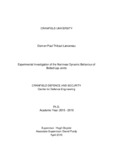JavaScript is disabled for your browser. Some features of this site may not work without it.
| dc.contributor.advisor | Goyder, Hugh | |
| dc.contributor.advisor | Purdy, David J. | |
| dc.contributor.author | Lancereau, Damien Paul Thibaut | |
| dc.date.accessioned | 2021-01-08T11:57:57Z | |
| dc.date.available | 2021-01-08T11:57:57Z | |
| dc.date.issued | 2019-04 | |
| dc.identifier.uri | http://dspace.lib.cranfield.ac.uk/handle/1826/16140 | |
| dc.description.abstract | The physics behind the vibration of joints is currently unknown and therefore unpredictable. Consequently in sensitive structures, like aircraft or turbines, prototype testing is necessary to evaluate the dynamic behaviour and avoid catastrophic failures. The thesis objective is to reduce the unpredictability by identifying the dominant parameters linked to bolted lap joint nonlinear behaviour. This study has found that the size of the interface had the most impact. A large interface creates a receding contact which created an amplitude dependent damping and stiffness. In contrast, a small interface creates a complete contact, with limited nonlinear behaviour. In-between interface sizes involved a lock-up which was interpreted as amplitude dependent slip or bound regions in the lap joint interface. Accordingly, the bending moment dynamic loading at the joint location is correlated to the nonlinear behaviour, only if there is a receding contact. This correlation between bending and damping was interpreted as a rolling effect with a changing contact patch during a cycle of vibration, which creates a specific behaviour in different regions of the lap joint interface. An experimental approach was used to reach these conclusions. The use of shims allowed the comparison of seven sizes of interfaces on the same structure. Then, a novel method was developed to measure the effect of a receding contact at 18 joint locations, by placing or removing washer-size-shims in a beam with 18 identical lap joints. Hammer impact excitation allowed the 12 first bending modes to be measured with minimum interference. The decaying vibration time histories were filtered and fitted in the time domain, using novel signal processing methods, to extract the amplitude dependant damping ratio and natural frequencies. Also, a finite element simulation enabled the natural frequency to be predicted, using an approximated contact patch. | en_UK |
| dc.language.iso | en | en_UK |
| dc.relation.ispartofseries | PHD;PHD-19-LANCEREAU | |
| dc.rights | © Cranfield University, 2019. All rights reserved. No part of this publication may be reproduced without the written permission of the copyright holder. | |
| dc.title | Experimental investigation of the nonlinear dynamic behaviour of bolted lap joints | en_UK |
| dc.type | Thesis | en_UK |
